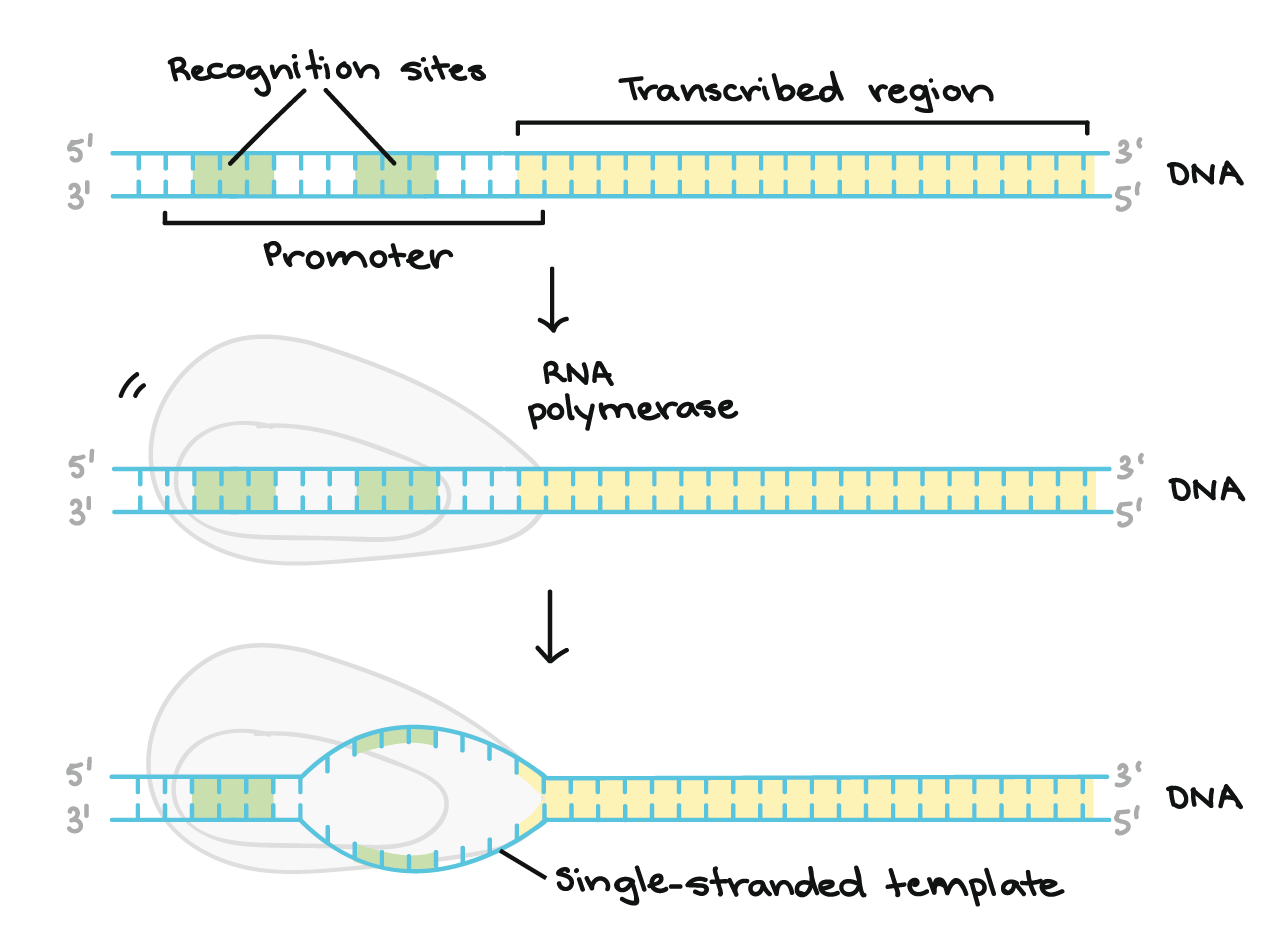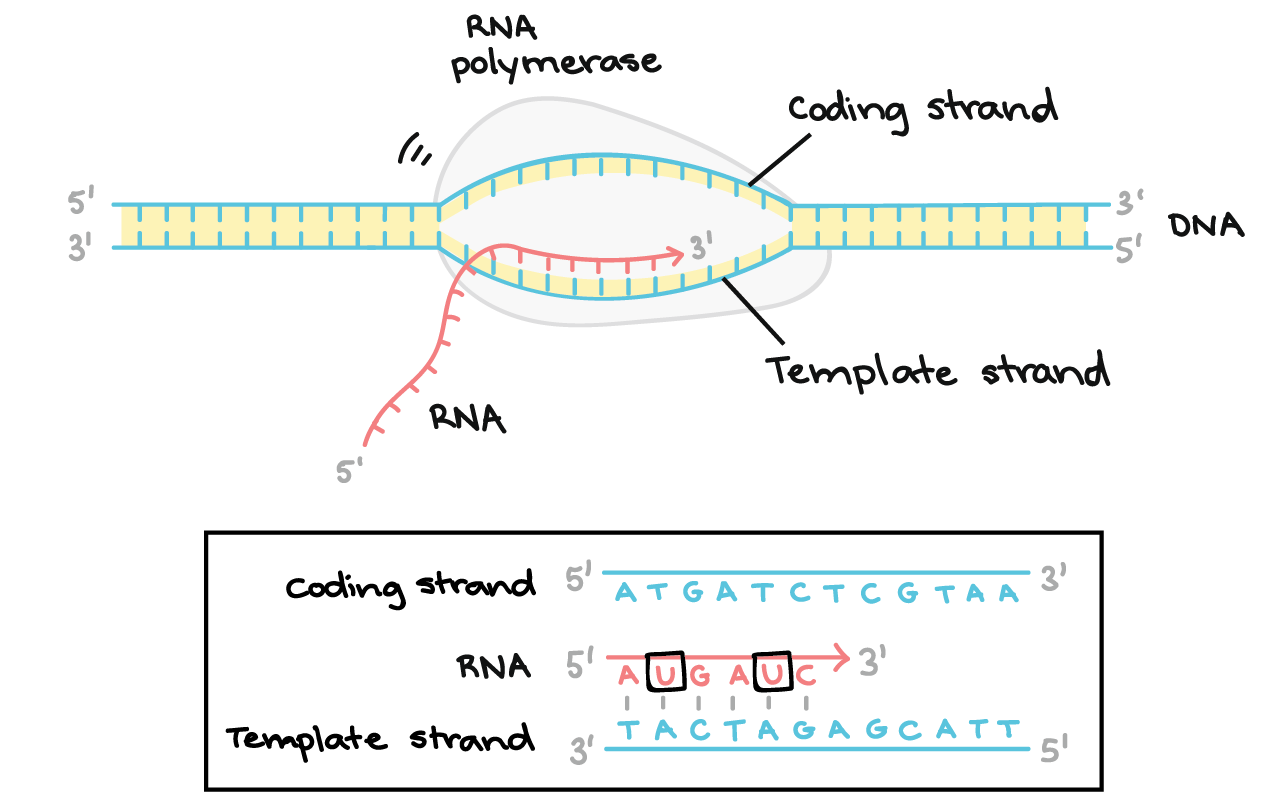Answer :A
Key points:
-
Transcription is the first step in gene expression. It involves copying a gene's DNA sequence to make an RNA molecule.
-
Transcription is performed by enzymes called RNA polymerases, which link nucleotides to form an RNA strand (using a DNA strand as a template).
-
Transcription has three stages: initiation, elongation, and termination.
-
In eukaryotes, RNA molecules must be processed after transcription: they are spliced and have a 5' cap and poly-A tail put on their ends.
-
Transcription is controlled separately for each gene in your genome.
Introduction
Have you ever had to transcribe something? Maybe someone left a message on your voicemail, and you had to write it down on paper. Or maybe you took notes in class, then rewrote them neatly to help you review.
As these examples show, transcription is a process in which information is rewritten. Transcription is something we do in our everyday lives, and it's also something our cells must do, in a more specialized and narrowly defined way. In biology, transcription is the process of copying out the DNA sequence of a gene in the similar alphabet of RNA.
Overview of transcription
Transcription is the first step in gene expression, in which information from a gene is used to construct a functional product such as a protein. The goal of transcription is to make a RNA copy of a gene's DNA sequence. For a protein-coding gene, the RNA copy, or transcript, carries the information needed to build a polypeptide (protein or protein subunit). Eukaryotic transcripts need to go through some processing steps before translation into proteins.

In transcription, a region of DNA opens up. One strand, the template strand, serves as a template for synthesis of a complementary RNA transcript. The other strand, the coding strand, is identical to the RNA transcript in sequence, except that it has uracil (U) bases in place of thymine (T) bases.
Example:
Coding strand: 5'-ATGATCTCGTAA-3' Template strand: 3'-TACTAGAGCATT-5' RNA transcript: 5'-AUGAUCUCGUAA-3'
For a protein-coding gene, the RNA transcript contains the information needed to synthesize a polypeptide (protein or protein subunit) with a particular amino acid sequence. In this case:
RNA transcript (acting as messenger RNA): 5'-AUGAUCUCGUAA-3' Polypeptide: Met-Ile-Ser-STOP
RNA polymerase
The main enzyme involved in transcription is RNA polymerase, which uses a single-stranded DNA template to synthesize a complementary strand of RNA. Specifically, RNA polymerase builds an RNA strand in the 5' to 3' direction, adding each new nucleotide to the 3' end of the strand.

RNA polymerase synthesizes an RNA strand complementary to a template DNA strand. It synthesizes the RNA strand in the 5' to 3' direction, while reading the template DNA strand in the 3' to 5' direction. The template DNA strand and RNA strand are antiparallel.
RNA transcript: 5'-UGGUAGU...-3' (dots indicate where nucleotides are still being added at 3' end) DNA template: 3'-ACCATCAGTC-5'
Stages of transcription
Transcription of a gene takes place in three stages: initiation, elongation, and termination. Here, we will briefly see how these steps happen in bacteria. You can learn more about the details of each stage (and about how eukaryotic transcription is different) in the stages of transcription article.
-
Initiation. RNA polymerase binds to a sequence of DNA called the promoter, found near the beginning of a gene. Each gene (or group of co-transcribed genes, in bacteria) has its own promoter. Once bound, RNA polymerase separates the DNA strands, providing the single-stranded template needed for transcription.

The promoter region comes before (and slightly overlaps with) the transcribed region whose transcription it specifies. It contains recognition sites for RNA polymerase or its helper proteins to bind to. The DNA opens up in the promoter region so that RNA polymerase can begin transcription.
- Elongation. One strand of DNA, the template strand, acts as a template for RNA polymerase. As it "reads" this template one base at a time, the polymerase builds an RNA molecule out of complementary nucleotides, making a chain that grows from 5' to 3'. The RNA transcript carries the same information as the non-template (coding) strand of DNA, but it contains the base uracil (U) instead of thymine (T).
[What do 5' and 3' mean?]

RNA polymerase synthesizes an RNA transcript complementary to the DNA template strand in the 5' to 3' direction. It moves forward along the template strand in the 3' to 5' direction, opening the DNA double helix as it goes. The synthesized RNA only remains bound to the template strand for a short while, then exits the polymerase as a dangling string, allowing the DNA to close back up and form a double helix.
In this example, the sequences of the coding strand, template strand, and RNA transcript are:
Coding strand: 5' - ATGATCTCGTAA-3'
Template strand: 3'-TACTAGAGCATT-5'
RNA: 5'-AUGAUC...-3' (the dots indicate where nucleotides are still being added to the RNA strand at its 3' end)
-
Termination. Sequences called terminators signal that the RNA transcript is complete. Once they are transcribed, they cause the transcript to be released from the RNA polymerase. An example of a termination mechanism involving formation of a hairpin in the RNA is shown below.

The terminator DNA encodes a region of RNA that forms a hairpin structure followed by a string of U nucleotides. The hairpin structure in the transcript causes the RNA polymerase to stall. The U nucleotides that come after the hairpin form weak bonds with the A nucleotides of the DNA template, allowing the transcript to separate from the template and ending transcription.
.